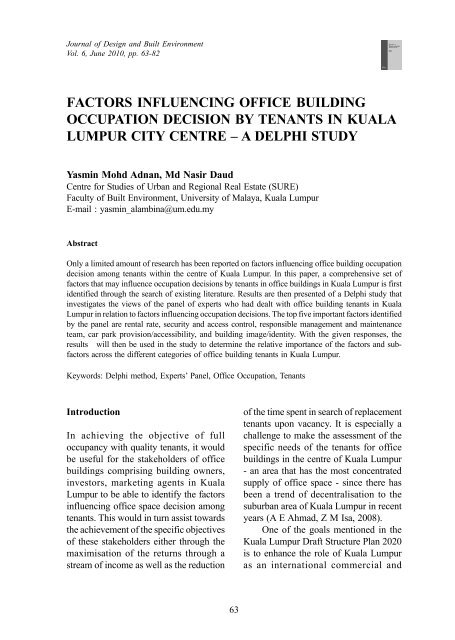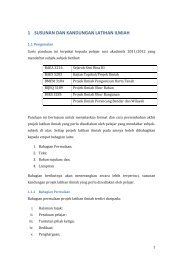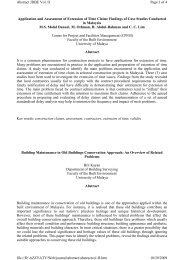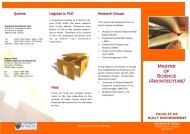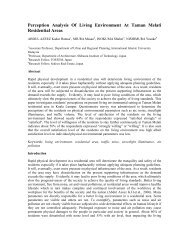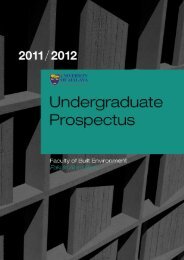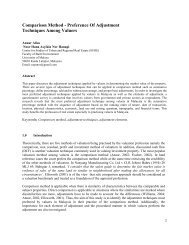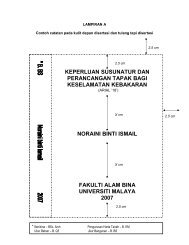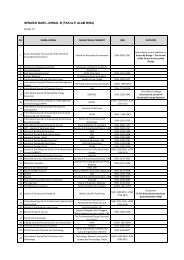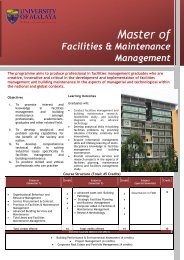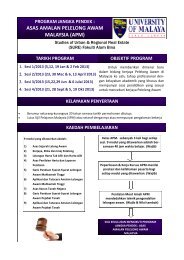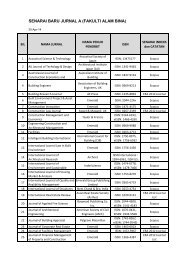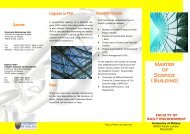Factors Influencing Office Building Occupation Decision by Tenants ...
Factors Influencing Office Building Occupation Decision by Tenants ...
Factors Influencing Office Building Occupation Decision by Tenants ...
Create successful ePaper yourself
Turn your PDF publications into a flip-book with our unique Google optimized e-Paper software.
Journal <strong>Factors</strong> of <strong>Influencing</strong> Design and <strong>Office</strong> Built <strong>Building</strong> Environment <strong>Occupation</strong> <strong>Decision</strong> <strong>by</strong> <strong>Tenants</strong> in Kuala Lumpur city centre – a Delphi StudyVol. 6, June 2010, pp. 63-82FACTORS INFLUENCING OFFICE BUILDINGOCCUPATION DECISION BY TENANTS IN KUALALUMPUR CITY CENTRE – A DELPHI STUDYYasmin Mohd Adnan, Md Nasir DaudCentre for Studies of Urban and Regional Real Estate (SURE)Faculty of Built Environment, University of Malaya, Kuala LumpurE-mail : yasmin_alambina@um.edu.myAbstractOnly a limited amount of research has been reported on factors influencing office building occupationdecision among tenants within the centre of Kuala Lumpur. In this paper, a comprehensive set offactors that may influence occupation decisions <strong>by</strong> tenants in office buildings in Kuala Lumpur is firstidentified through the search of existing literature. Results are then presented of a Delphi study thatinvestigates the views of the panel of experts who had dealt with office building tenants in KualaLumpur in relation to factors influencing occupation decisions. The top five important factors identified<strong>by</strong> the panel are rental rate, security and access control, responsible management and maintenanceteam, car park provision/accessibility, and building image/identity. With the given responses, theresults will then be used in the study to determine the relative importance of the factors and subfactorsacross the different categories of office building tenants in Kuala Lumpur.Keywords: Delphi method, Experts’ Panel, <strong>Office</strong> <strong>Occupation</strong>, <strong>Tenants</strong>IntroductionIn achieving the objective of fulloccupancy with quality tenants, it wouldbe useful for the stakeholders of officebuildings comprising building owners,investors, marketing agents in KualaLumpur to be able to identify the factorsinfluencing office space decision amongtenants. This would in turn assist towardsthe achievement of the specific objectivesof these stakeholders either through themaximisation of the returns through astream of income as well as the reductionof the time spent in search of replacementtenants upon vacancy. It is especially achallenge to make the assessment of thespecific needs of the tenants for officebuildings in the centre of Kuala Lumpur- an area that has the most concentratedsupply of office space - since there hasbeen a trend of decentralisation to thesuburban area of Kuala Lumpur in recentyears (A E Ahmad, Z M Isa, 2008).One of the goals mentioned in theKuala Lumpur Draft Structure Plan 2020is to enhance the role of Kuala Lumpuras an international commercial and63
Yasmin Mohd Adnan, Md Nasir Daudfinancial centre in line with the aspirationto make Kuala Lumpur a world class city,.However, its development strategy for thecity centre is to have a moderate growthin order not to exacerbate the oversupplyof commercial space in the city. Themotivations for striving towards a worldclass status for major cities in the regionare many including national pride and thefact that a world class city is seen as ananswer to the critical problem of makinga successful transition from low wageassembly platforms to technical advancedproduction and high order corporateservice centre (Douglass, 2000).Drawing from the above vision ofturning Kuala Lumpur into a world classcity, there are concerns highlighted in theKuala Lumpur Draft Structure Plan 2020on the commercial development. One ofthe concerns is the over-concentration ofoffice buildings in the city centre -especially of older buildings includingthose vacated <strong>by</strong> the relocation ofgovernment offices to Putra Jaya (the newgovernment administrative centre) -which are deficient in basic informationcommunication technology (ICT)facilities (Draft Structure Plan KualaLumpur, 2020).In spite of this concern, it has beengenerally noted that in most cities in theworld, the central business district(CBD), or the city centre, is referred toas the heart of the city where there is aconcentration of firms and officeemployment. It can often be regarded asthe engine of city growth which can filterits impact on other parts of the city. TheCBD is also often the focal point of a cityand its population where a highconcentration and diverse range of highvalue activities are found.The aim of the study is to promotethe achievement of the above vision <strong>by</strong>identifying the factors consideredimportant <strong>by</strong> the major firms andorganisations in attracting and retainingthem in Kuala Lumpur, specifically in thecity centre.In this paper, a comprehensive setof factors and sub-factors that mayinfluence office space occupationdecision were first identified from theliterature. Then, a Delphi procedure wasemployed to elicit expert knowledge inidentifying the important factors and subfactorsin Kuala Lumpur. A panel ofexperts comprising property consultantsand property/leasing managers of topquality office buildings participated in thestudy. The result was then to be used inthe determination of the relativeimportance of the factors and sub-factorsacross the different categories of officebuildings’ tenants in Kuala Lumpur citycentre. These tenants were to be selectedfrom top quality office buildings withgrades (Premium, A and B) identifiedfrom an earlier study to classify officebuildings in Malaysia (Yasmin et al,2009).<strong>Office</strong> Market in Kuala LumpurThere has been a tremendoustransformation of the Kuala Lumpur citycentre since it first started as the centreof trade and later to become the capitalcity. Starting out as a tin mine settlementin 1867, Kuala Lumpur has progressedto attain city status in 1972 with an areaof 92 square kilometres (City Hall ofKuala Lumpur, 1991). Since the 1960sand the 1970s, Kuala Lumpur started to64
<strong>Factors</strong> <strong>Influencing</strong> <strong>Office</strong> <strong>Building</strong> <strong>Occupation</strong> <strong>Decision</strong> <strong>by</strong> <strong>Tenants</strong> in Kuala Lumpur city centre – a Delphi Studyportray its position as a centre of tradeand business. As the country progressesand moves past 50 years of independence,the initial central area of businessactivities of Kuala Lumpur, locatedbetween the two rivers of Klang andGombak,has undergone tremendouschanges. The manifestation of its physicalfunction as a centre of business and officelocation activities is seen in theemergence of the Golden Triangle area(the area bounded <strong>by</strong> Jalan Ampang,Jalan Sultan Ismail and Jalan BukitBintang) which is built upon withinternational hotels and office andcommercial blocks. At the same time, theprevious Central Business District (CBD)of Kuala Lumpur that used to be thetraditional city centre, remains as thebusiness and trade area with colonialeconomic features (Morshidi, 2002).In most large cities, the centralbusiness district is such area as is said tobe dominated <strong>by</strong> a limited number ofcompetitors in the urban system, and thedominant land uses are associatedtypically with major banks, corporateoffice buildings, department stores,theatres, and other leading business,commercial, or entertainment uses(Kleinberg, 1995). Thus, CBD is easilydistinguishable <strong>by</strong> its centrality, easyFigure 1: Distribution of <strong>Office</strong> <strong>Building</strong>s <strong>by</strong> Status, 200065
Yasmin Mohd Adnan, Md Nasir Daudaccessibility and clustering of up marketcommercial organisations and tertiaryemployment. Information is vastlycollected, processed and disseminated inthis area. Thus CBD is a highly dynamicplace that is normally associated with fastpace of life (Tang, Yeung, 1999).In Malaysia, the Kuala Lumpur citycentre has taken on different definitionsin the hands of different stakeholders. TheCity Hall of Kuala Lumpur has definedthe area as encompassing the centralbusiness location covering an area of18,125,660.4 sq metres (see Figure 1).The property professionals, on the otherhand, have varied definitions. TheNational Property Information Centre(NAPIC), Department of Valuation andProperty Services, Ministry of Finance,Malaysia has identified the officebuildings location in Kuala Lumpur as:Central Business District (CBD), JalanAmpang (JA), Golden Triangle (GT),Within City Centre (WCC) and Suburban(SU) area. The Central Business District(CBD), identified as the older part ofKuala Lumpur city, was gazetted inaccordance with the Comprehensive PlanNo 1039 in 1970. The office buildingslocated within the area are mainly builtbefore 1980s although some buildingshave undergone refurbishments.The definition of Kuala Lumpur citycentre has now changed in line with thegovernment aspiration of the city as aworld class city. The centre which wasformerly referred to as CBD now includesareas bounded within the GoldenTriangle, Jalan Ampang and Within CityCentre (WCC). For this study, thedefinition <strong>by</strong> City Hall Kuala Lumpur willbe adopted.The perceived need to influenceoffice location decision is described inthe Malaysian Planning documentations,the following extract being typical of thekinds of generalised policy objectivesincorporated in the Structure Plan suchas: i) to promote Kuala Lumpur as achoice location for internationalorganisations and business entities toestablish their regional offices andheadquarters and ii) to create atechnologically advanced city especiallyin the fields of building technology anddesign as well as information andcommunication technology (Draft KLStructure Plan, 2020). Much of the policymaking and planning initiatives arefocussed on the development companiesand others that supply office premises, inthe expectation and hope that the latterare able to accurately assess therequirements of the occupiers. Analternative to such a supply-orientatedapproach, an examination of theoccupational motives of the occupants ofthe office buildings, is advocated here.While older office buildings locatedin secondary location or on the fringe ofCBD area are said to be more susceptibleto being left vacant due to their unpopularoffice addresses and poor buildingimages, similar buildings located close tothe Kuala Lumpur City Centre (KLCC),an area within the Golden Triangle areagained from the strategic location andcontinued to enjoy sustainable occupancyrates (Rahim & Co, 2006).By the third quarter of 2009, thereare approximately 6.3 million squaremetres (68 million square feet) of officespace in Kuala Lumpur (NAPIC, Q3,2009). Of this amount, 79% is located66
<strong>Factors</strong> <strong>Influencing</strong> <strong>Office</strong> <strong>Building</strong> <strong>Occupation</strong> <strong>Decision</strong> <strong>by</strong> <strong>Tenants</strong> in Kuala Lumpur city centre – a Delphi Studywithin the area demarcated <strong>by</strong> the CityHall of Kuala Lumpur as the KualaLumpur city centre. The averageoccupancy rate of the office space inKuala Lumpur is 84% while the averageoccupancy rate of the office space in thecity centre (as defined in the study) is 82%(NAPIC, Commercial Property StockReport, 2009).An overview of the occupancy rateof office space within the areas in KualaLumpur as defined <strong>by</strong> NAPIC (2009)shows varying figures as follows:Table 1: Occupancy Rate of <strong>Office</strong> Spacein Kuala Lumpur ((NAPIC, Q3, 2009)Defined Area Occupancy RateGolden Triangle 82%Jalan Ampang 95%Central Business 85%DistrictWithin City Centre 83%Suburban 83%There has been a slight improvementof the office market over the past fewyears before the economic crisis of 2008as evidenced <strong>by</strong> the improvement in thetake-up rates of office space in the KualaLumpur office market for the period upto 2007. An observation of the 10-yearsupply trend from 1997 to 2007 isillustrated below.Cross-sectional analysis <strong>by</strong> locationand various development stages showspertinent movements over the 10-yearperiod from 1997 up to 2007. Althoughthere has been an increasing trend ofsupply in the suburban area, the KualaLumpur city centre still has the largestconcentration of office supply.<strong>Factors</strong> relevant to office occupationdecisionsWhile a number of studies have beenpublished in other countries on the overallrequirements of office tenants for officeFigure 2: Supply of <strong>Office</strong> Space <strong>by</strong> Location(Source: A E Ahmad, Z M Isa, 2008, NAPIC (various publications, 1998 – 2008))67
Yasmin Mohd Adnan, Md Nasir Daudoccupation, limited number of study isknown to exist that examines theimportant factors considered <strong>by</strong> the majortenant organisations in Malaysia. Thereappears to be a lack of precise knowledgefor commercial property stakeholdersespecially property managers, owners/investors and leasing agents in KualaLumpur to gauge the importantconsiderations of the office space as a‘product offering’ for occupation/leasingdecision.Historically, it has been claimed thatfirms choose to cluster in a centre thatoffers comparative advantage (Sing, Ooi,Wong, Lum, 2004). This gives rise to highconcentration of employment whichevolved through CBD (Marshall, 1961;Krugman 1991, Sing et. al., 2004). WhenCBD grows and reach a critical size,agglomeration benefits diminish (trafficcongestion, increased office density etc.).The tenants’ firms are more ready to tradeoff agglomeration economies for otheradvantages in new office location.Subcentres are formed as a result of theoutward movement from the CBD(Richardson, 1978; DiPasquale andWheaton, 1996). In an earlier study onthe future of the city centres for propertyinvestments <strong>by</strong> Richard Ellis in 1996,office occupiers have indicated thefollowing factors when consideringrelocating. They are total buildingoccupational costs, quality of buildings,road infrastructure, security of the area,availability of staff, availability of carparking, quality of life for employees,access to client/target market, skills ofstaff, out of city centre, prestige location,rail and air infrastructure, competingcompanies in the area and city centrelocation. Total building costs and thequality of accommodation are the mostimportant factors while city centrelocation is the least important factor.Agglomeration economies (Clapp,1980; Bollinger et al., 1998) as anextension of the location literature havebeen identified as an important factor forthe central location of firms. However,the role of face-to-face contact and theassociated of agglomeration economiesis not the only factor determining thelocation of a firm. Alexander (1979)argues against the over-emphasis of thisfactor and identifies other factors whichinclude tradition, distance from the mostprestigious addresses, proximity to innercity train station, link with commuter trainand bus network or closeness to the mainshopping centre. The need for face to-facecontact and accessibility has beenquestioned with the advent of informationand communication technology (ICT).However, it was also found that astechnology progresses, the effect of IT isnominal on the demand for office space(Peter Dent et al (1998)). On the otherhand, another study in Singapore hadshown that the advent of ICT had reducedthe need for face-to-face contact withcustomers and suppliers (Tien Foo Sing,et al, 2004).There has been a strong propositionthat within the location factors,accommodation has been overlooked(Louw, 1998). It was found that locationhas a major role in the decision makingprocess, in particular for firms that wantto rent office space. It is said that firmsthat rent office space are dependent uponthe supply offered on the real estatemarket and what it offers. Thus, the coreof the accommodation issue lies inbridging the gap between the static nature68
<strong>Factors</strong> <strong>Influencing</strong> <strong>Office</strong> <strong>Building</strong> <strong>Occupation</strong> <strong>Decision</strong> <strong>by</strong> <strong>Tenants</strong> in Kuala Lumpur city centre – a Delphi Studyof buildings and the dynamicdevelopment of organisations that haveresponded to technical developments andquickly changing markets. The type andsize of premises will affect theproductivity of the firm (Louw, 1998).Examining the behavioural approachto firm relocation decision, it has beenmentioned that there are given push andpull factors in the process. Frequently,push reasons are both internal andexternal to the firm. The main internalreason is related to pressure from growth:limited expansion space at currentlocation or limited representivity of thepresent location (the need for it usuallyincreases with the size and age of thefirm). External factors include limitedaccessibility, deterioration of thebuilding, environmental considerations,limited labour supply or high locationcosts. Pull factors are largely the oppositeof the internal factors: enough space,accessibility to deliverers, suppliers,customers, the labour market,representivity, low costs and oftenlocational amenities (Pallenberg et al,2002). Studies have been conducted toexplore the pull and push factors onlocation, building and organisationallevels (Pen, 2002). Many of the factorsthat relate to these levels are from thebehavioural context and are locationspecific which relate to the premise,organization or the environment.The heterogeneity of office stockshas since then been included in studiesto determine office space decision. On thedemand side, assumption as to firmsbeing rational, homogeneous and haveperfect information on their choice ofoffice location decision has beenquestioned (Wyatt, 1999; Leishman;Watkin, 2004 and Leishman, Dunse,Warren and Watkin, 2003, Sing, Ooi,Wong, Lum, 2004). These studies providefindings that the office space preferencedecision varies between different typesof occupiers. The occupiers’characteristics which influence the officespace decision may vary between theirnature and priorities. A study on thedifferent profiles of occupiers inSingapore major commercialdevelopment revealed that firms placedsignificant importance on face-to-faceconvenience, image and branding of theoffice location (Sing et al, 2004).In an earlier study to determine thecauses and patterns of new space demandin Australian commercial propertymarket, it was found that there are macroand micro influences in the decisionmaking process (Higgins, 2000). They arethe property market dynamics, technicalchange, political factors, economicfactors, building locality, business profile,cost implications, lease arrangements andoccupiable space. Thus it can be derivedthat the commercial property landscapeis changing to accommodate therequirements of organisations. While itwould be useful to examine the impactof the economic and political factors onthe decision making process for officeoccupation, these factors are excluded inthis study considering that they are not‘product offering’ specific.While the age of buildings may beone of the factors of consideration, astudy had pointed out that there is nostraightforward relationship between ageof building and the degree ofobsolescence (Richard Barras et al(1996). In a study of depreciation of theoffice market in Kuala Lumpur for the69
Yasmin Mohd Adnan, Md Nasir Daudperiod of 1996 and 1998, buildingobsolescence had largely been attributedto the impact of depreciation, which areproperty specific factors (Md Yusof A,2000). Variations in offices’characteristics as denoted <strong>by</strong> siteobsolescence, building obsolescence andphysical deterioration explained the scaleof depreciation of the offices in the cityof Kuala Lumpur. Among these three,physical deterioration and obsolescencewere found to be the major sources ofdepreciation. It would be worthy to notethat age and the physical conditions ofthe office buildings are important factorsof consideration for occupation.A satisfied tenant is more committed,tend to be loyal and not move (Dogge,2004). Various studies on the tenants’occupation within office buildings havebeen examined. Riannce (2007) in a studyin Netherlands explored the keep factorsthat could retain tenants as they becomesatisfied at the existing office. It wasdiscovered that there can never be certainkeep factors for an office space decisionas they tend to be exchanged with thepush/pull factors. The important push/pull factors seem to be building factorswhile the important keep factors seem tobelong to the buildings and thesurroundings.Babcock (2003) discussed theBOMA International results of survey ontenant satisfaction and tenant retention.The paper discussed the factors ofconsideration for tenants’ retention whichinclude adding up amenities where<strong>by</strong>tenants look for a physical place insynchronisation with its current status.Location was ranked as the most crucialconsideration in tenant attraction andretention whilst technology was the mostsignificant factor. CBE, University ofCalifornia (1999) made a study on whatoffice tenants want and how much theyare willing to pay. The traditional areasof real estate decision-making weredescribed highlighting the major factorsunder consideration. Sullivan (2006)highlights the results of a surveyconducted among landlords and tenants(involving 6,642 readers of <strong>Building</strong>Operations Management) as to the levelof satisfaction derived from leased space.The survey shows that a majority oftenants are consistently satisfied withmore than two-third of their landlords andto responsiveness to requests andcomplaints.RICS Tenant Satisfaction Index(2005) describes the index developed inproviding an insight into the health oftenant relationships in the UK propertyindustry. It is a measure of tenantsatisfaction on the services provided <strong>by</strong>landlords. The study revealed that variouscomponent of performance used need notinclude location but also to includestandard of premises and value for money,landlord and agent communication,contract detail (ease of contract alterationand problem resolution. lease flexibility).Historically, the main concerns of a tenanthave been location, standard and rent. Ina study to determine the main factors thatdetermine the consumer choice for officespace in Riga Latvia, good location,parking availability, rent and officeinfrastructure emerged as important(Beltina, 2006).A research report entitled “Why rentin Kuala Lumpur” <strong>by</strong> the NationalInstitute of Valuation (INSPEN),Malaysia in 1993 examined the keyselection criteria for office space70
<strong>Factors</strong> <strong>Influencing</strong> <strong>Office</strong> <strong>Building</strong> <strong>Occupation</strong> <strong>Decision</strong> <strong>by</strong> <strong>Tenants</strong> in Kuala Lumpur city centre – a Delphi Studyoccupation in Kuala Lumpur. Key factorsidentified were location, building design,building services, rental rates andbuilding image. The study also revealedthat a majority of the buildings aremanaged in-house. It was also generallyobserved that the tenants in the GoldenTriangle Area were more maintenanceconscious than their counterparts in theCBD area, possibly due to their derivedexpectation of the better quality servicesto correspond with the comparativelyhigher service charge levied on them. Thestudy however did not specifically rankthe importance of the facilitiesaccordingly or gauge the level of tenantsatisfaction in terms of expectation andperformance towards the factorsidentified. It is interesting to note thatvarious factors have been identified tosolicit tenants’ requirements fromprevious studies and it would useful tofind out whether these factors are stillrelevant in the current market office andbusiness scenario in Kuala Lumpur.There are numerous factors invarying degrees that may influence tenantoffice occupation decision. It can beobserved that there are four main areaswhich can be said to encompass the“product offering” to the tenant as aconsumer. Monetary factors have beenone of the considerations and so are theother factors such as location, leasefeatures and building or physicalcharacteristics of the space. A summaryof the comprehensive set of factors andsub factors that are potentially relevantto office occupation decisions ashighlighted in the literature is illustratedin Table 1.While it would be interesting to notethe factors highlighted in previousstudies, it would be useful to determinethe factors considered relevant <strong>by</strong> tenantsin the office buildings in Malaysia <strong>by</strong>soliciting the views of the propertyconsultants/leasing experts in KualaLumpur. The initial part of the studyinvolves the derivation of importantfactors that are relevant in the KualaLumpur office market <strong>by</strong> seeking theviews of the property experts. They arechosen among senior managers ofproperty consultancy firms and property/building managers that have dealt withthe tenants in top grade office buildingsat Kuala Lumpur city centre.The Delphi ApproachIn seeking the views of the experts andidentifying the factors that are importantto tenants in office occupation decisionin Kuala Lumpur, Malaysia, a Delphiapproach was adopted. This approachwas chosen as it is an iterative approachused to collect and distill the judgmentsof experts using a series of questionnairesinterspersed with feedback. It is oftenused as a qualitative forecastingtechnique but is also used to investigateand understand the factors that mayinfluence decision making on a specificissue, topic or a problem area. The Delphimethod has its origins in the Americanbusiness community and has since beenwidely accepted throughout the world inmany industry sectors including healthcare, defence, business, education,information technology, transportationand engineering. Delphi has found its wayinto industry, government, and finally,academia. It has simultaneouslyexpanded beyond technological71
Yasmin Mohd Adnan, Md Nasir DaudTable 1: Summary of Main <strong>Factors</strong> and Sub <strong>Factors</strong> affecting <strong>Office</strong> <strong>Occupation</strong><strong>Decision</strong>Main <strong>Factors</strong>LocationLease FeaturesMonetary Consideration<strong>Building</strong> Features and ServicesSub-<strong>Factors</strong>Branding/Image; Access to Market, Amenities, Skilled LabourPool; Access to Cheap/non-skilled Labour; Convenience toResidential Area; Proximity to Similar Business; Proximity toComplementary Business, Proximity to support services suppliers,Factor of Production Costs, Access to Raw Materials, Proximityto Investors, Corporate Headquarters, Financiers, Specialisedservices, Government Authorities related to Business; Accessibilityto Public Transport Terminal, Major Trunk Roads/highways;Accessibility to Public Transportation, <strong>by</strong> Private Vehicle;Proximity to other sub urban centres; Market Size; Visibility/Exposure to Clients; Proximity to Competitors in Similar Business;Level of Criminal Rate, Pollution; Traffic ConditionUse of Premise; Indemnity; Compliance to Law and In HouseRegulations; Fitting Out Clause; Alteration and RenovationClause; Payment of Monies Clauses; Termination Clause; Review/Renewal Terms; Repair and Insurance; Assignment/Sublet; BreakClause; Lease/Contract length; IncentivesRental Rate; Service Charge Rate; Total Occupancy Cost; Cost ofFit Out; Running Cost; Cost of Exiting; Cost of InternalInfrastructure, Cost of <strong>Office</strong> AdministrationAge; No of Storey (height); Finishes Specifications; Design ofEntrance and Foyer; Modern Prestigious <strong>Building</strong>; Prominenceof Entrance; Quality of Reception; Quality & Presentation ofExternal Finishes; Common Space Area; <strong>Building</strong> Visibility;<strong>Building</strong> Identity/Image; External Façade; Internal Space Finishes;Quality architectural design and building finishesSecurity & Access Control; Responsible management andmaintenance teams; Maintenance policy; Cleaning/HousekeepingServices; Energy Conservation & Recycling Policies; ComputerBased Management/Maintenance Systems; Safety Policy &Procedure; Fire Prevention & Protection; Responsive to servicerequests; After Hours OperationFloor Plate Size; Floor-Ceiling Height; <strong>Building</strong> Size; FlexibleSpace Layout & Large Floor plate; Orientation of office space;Good geomancy / feng shui; Availability of space for futureexpansion; Comfortable & Secure Working Environment; SpaceEfficiency; Column layout & Subdivisibility; Floor Loading;Underfloor Trunking; Riser Space for ICT & Security Systems;Adequacy of Natural Lighting; Energy Efficient/ Green <strong>Building</strong>s;Design and Space Planning; Raised Floor72
<strong>Factors</strong> <strong>Influencing</strong> <strong>Office</strong> <strong>Building</strong> <strong>Occupation</strong> <strong>Decision</strong> <strong>by</strong> <strong>Tenants</strong> in Kuala Lumpur city centre – a Delphi Study(This study, 2009)Toilet & Sanitary Facilities; Air-conditioning system; Electricitysystem; Modern IT & Telecommunication system; <strong>Building</strong>automation & Energy Management System; Fire fighting system;Adequacy of Ventilation; Stand<strong>by</strong> Power Supply; EnergyGenerating Capacity; Control of M & E Services; Control of NoiseEase of Use of Entrance; Entrance Capacity; Location of Lifts,Stairs & Corridor; Capacity of Lifts; Speed of Lifts; PassengerLifts Performance & Control; Good Lifts & Loading Bay Design;Capacity of Stairs; Adequacy of Good; Access & Circulationfeature; Capacity of Corridors for movement; No of Car Parks;Car park ingress/egress to/from building; <strong>Building</strong> Way findinge.g. <strong>Building</strong> Directory/Signage; Ease of Disabled Circulation;Food & Beverage outlets; Sport & Recreational facilities;Landscaping; Bank, Postal & Retail Services; Provision ofVending & Catering Services; Conference facilitiesforecasting (Fowles, 1978). Since the1950s several research studies have usedthe Delphi method, particularly in publichealth issues and education areas (Adlerand Ziglio, 1996; Cornish, 1977).Overview of Delphi MethodFollowing the original method which wasdeveloped in the 1950s, the Delphimethod has evolved and been used acrossdisciplines to reach an outcome based onconsultative basis. It is based on astructured process for collecting andsynthesising knowledge from a group ofexperts <strong>by</strong> means of a series ofquestionnaires accompanied <strong>by</strong>controlled opinion feedback (Adler andZiglio, 1996). It is also a method forstructuring a group communicationprocess to facilitate group problemsolving and to structure models (Linstone& Turloff, 1975). The method can be usedas a judgment, decision-aiding orforecasting tool (Rowe & Wright, 1999),and can be applied to problems that donot lend themselves to precise analyticaltechniques but rather could benefit fromthe subjective judgments of individualson a collective basis (Adler & Ziglio,1996). The Delphi method is a mature anda very adaptable research method usedin many research arenas <strong>by</strong> researchersacross the globe. Green and Price (2000)have speculated on the future directionof facilities management using a Delphipanel in the UK. According to Turoff(1970), there are four possible objectivesor secondary goals for any Delphicexercise, namely:1. To explore or expose underlyingassumptions or information leadingto differing judgments;2. To seek out information that maygenerate a consensus of judgment onthe part of the respondent group;3. To correlate informed judgments ona topic spanning a wide range ofdisciplines;4. To educate the respondent group asto the diverse and interrelatedaspects of the topic.73
Yasmin Mohd Adnan, Md Nasir DaudSince Delphi is founded on the oldpremise that the opinions of more than aperson are better, it utilises the use ofpanels of experts for obtaininginformation. It will then systematicallyattempt to produce a consensus ofopinion, and sometimes more importantlyidentify opinion divergence. It providesanonymity of both the experts andidentification of the expert’s statementsthroughout the exercise.Within the extended use of theDelphi Method, a series of rounds ofcommunication between the experts shallbe made and between which a summaryof the results of the previous round iscommunicated to and evaluated <strong>by</strong> theparticipants. The second and successiverounds often produce “a narrowing of theinitial spread of opinions and shifting ofthe median .... If no consensus emerges,at least a crystallizing of the disparatepositions usually becomes apparent”(Gordon, 1971).Strengths and WeaknessesThe major advantage of using the DelphiMethod is that it permits the researcherto obtain an objective consensus of expertjudgment on the subject under study. Italso makes the rationale underlying aspecific estimate or prediction explicit foreveryone. There have been several studies(Ament, 1970; Wissema, 1982; Helmer,1983) supporting the Delphi method.These studies seem to suggest that ingeneral, the Delphi method is useful toexplore and unpack specific, singledimensionissues. As Enzer et al (1971)observe, Delphi sessions are usuallybetter than other methods for eliciting andprocessing judgmental data, since theymaintain attention directly on the issue,provide a framework within whichindividuals with diverse backgrounds orin remote locations can work together onthe same problems, and produce precisedocumented records.On the other hand, the mainweakness of the Delphi Method is that atruly perspicacious expert’s judgmentmight be lost when a consensus thatactually represents a range of judgmentsis presented. Therefore, it is important toinclude judgments outside the consensusin footnotes or appendixes, asappropriate. Another weakness is that inface-to-face Delphi sessions, “GroupThink” problems may occur when someexperts may be swayed more <strong>by</strong> therhetoric or strength of personality of oneexpert and tend to discount the validityof other experts’ arguments. It is usuallyslow and time-consuming. If the Delphiis carried out through the mails with alarge panel, each round could take severalmonths. However, if it is conducted in aconference environment, the preparationof rounds and collation of responsescould be a matter of hours.Administration and ImplementationThe basic Delphi Method begins with aseries of first round questions askedindividually of experts to submit theirjudgments on the subject. The results ofthe first round judgments are thentabulated and the results are sent back tothe experts for modification. In essence,the experts are asked in the second roundto reevaluate their original judgments inlight of the average estimates calculatedin the first round. This procedure ofreevaluation is continued for several74
<strong>Factors</strong> <strong>Influencing</strong> <strong>Office</strong> <strong>Building</strong> <strong>Occupation</strong> <strong>Decision</strong> <strong>by</strong> <strong>Tenants</strong> in Kuala Lumpur city centre – a Delphi Studyrounds until a fairly high degree ofconsensus is reached, or until the expertsno longer modify their previousestimates.Selecting research participants is acritical component of Delphi researchsince it is their expert opinions uponwhich the output of the Delphi is based(Ashton 1986; Bolger & Wright 1994;Parente, Anderson, Myers, & O’Brien,1994). The sample size varies in theirstudies from 4 to 171 “experts”. As such,it can be concluded that there is no“typical” Delphi; rather that the methodis modified to suit the circumstances andresearch question.Undertaking the Delphi Method forthis StudyThe Delphi Panel and the DelphiProcessThe focus of the study was the elicitationof knowledge and opinion fromindividuals with broad cross-sectionalperspectives on tenants’ selection foroffice space occupation decisions. Theaim here was to survey field experts’perspectives of tenants’ selection of therelevant and important factors with a viewto consolidating the factors listed in Table1. Thus tenants were not selected asrespondents in this survey but rather wereinvolved separately in a different part ofthe study. The panel of respondents wasdesigned to have representatives fromtwo groups comprising the propertyconsultants/leasing agents fromestablished firms who generally interactwith prospective tenants and property/leasing managers of top grade officebuildings in Kuala Lumpur. A total offorty persons i.e. twenty from each groupwere invited to participate in the firstround of the study. The study wasconducted in the strict confidencethroughout and anonymity wasguaranteed to respondents.The first round of the questionnairewas emailed to the panellists in midNovember 2009. Reminder notices viaemail and telephone calls were sent to allexperts who had not replied between lateNovember and early December 2009. Atotal of 27 panellists agreed to participatein the first round of the survey, giving aresponse of 70 percent. They compriseseventeen (17) property consultants/agents who hold senior managementposts and ten (10) property/buildingmanagers. The questionnaire wasdesigned on a five-point Likert scale tomeasure a range of opinions from “Notvery important” to “Very important”. TheStatistical Package for Social Sciences(SPSS) was employed to analyse the datausing the Descriptive Statistics.The first round responses werecollated and analysed and an interimfinding was sent back to the first roundparticipants in late December 2009 inorder to get feedback and comments.During the second round of the survey,the experts are given only the measuresof central tendency for the responsesselected <strong>by</strong> experts in the first round, andare asked to explain in detail when theirsecond round judgments differsubstantially from the first round’smeasures of central tendency. Theprocedure however stopped at the secondround when most of the experts decidedagainst varying from their first roundresponses despite being presented withevidence of different opinions from other75
Yasmin Mohd Adnan, Md Nasir Daudrespondents. A total of 20 panellistsreplied to the second round to yield aresponse rate of 71 percent. The responsefrom the second round demonstratedstrong agreement on the broad findings.Overall, it was felt that a third round ofthe study would not add further to theunderstanding already gained during thefirst and second round and thus the studywas concluded. The results of the studybased on the two rounds are presentedhere.level of crime. The least important factorsare factors of production cost and accessto raw materials and semi-finishedproducts. Considering that the businessesare mainly service orientated in nature inthe central business district, it can beobserved that the responses given <strong>by</strong>panels are in tandem with the some ofthe factors highlighted earlier in theliterature although the impact ofagglomeration remains to be exploredfurther.Findings and DiscussionIn the first round, the panellists wereasked to rate the importance of factorsunder each category of economic/monetary consideration, location, leasefeatures, and building features, servicesand management. From the list of factorslisted in Table 1, the panels’ choices ofthe important factors under the variouscategories are presented in Table 2. Sincethere were no changes to the responsesin the second round, the factors identifiedin the earlier round were taken to be theimportant factors.Figures 1, 2, 3 and 4 reveal therelative importance of the various subfactors through the responses obtainedfrom the panel during the first round.The importance of factor: LocationUnder the location category, the top fivefactors that have been rated as important<strong>by</strong> the panel of experts are image/branding of the location, access toamenities, accessibility to public transportand terminal, traffic condition and theThe importance of factor: LeaseFeaturesUnder the lease features category, the topthree factors that have been rated asimportant <strong>by</strong> the panel of experts are:renewal terms, length of the lease andtermination clause. It can be seen that thetenants consider security of tenureimportant to cover the term of theirbusiness activities as in the use of theoffice space.The importance of factor: <strong>Building</strong>Features, Services and ManagementUnder the building features, services andmanagement, the top five importantfactors are: responsible management andmaintenance team, security and accesscontrol, car park provision andaccessibility, building image and identityand modern IT and communicationsystems. With the responses givenhighlighting the building offering, it canbe said that the important factors relateto the provision of top quality servicesand image that serve to support theactivities of the tenants.76
<strong>Factors</strong> <strong>Influencing</strong> <strong>Office</strong> <strong>Building</strong> <strong>Occupation</strong> <strong>Decision</strong> <strong>by</strong> <strong>Tenants</strong> in Kuala Lumpur city centre – a Delphi StudyTable 2: Summary of the Mean and Standard Deviation of the selected important factorsfor location, lease features, building features, services & management and monetaryconsiderationEvaluation <strong>Factors</strong> Mean Standard Deviation1. Locationa. Branding/Image 4.3 4.0 0.6b. Access to Amenities 4.3 4.0 0.6c. Accessibility to Public Transportation and Terminal 4.1 4.0 0.7d. Traffic Conditions 4.1 4.0 0.7e. Level of Crime 4.0 4.0 1.12. Lease Featuresa. Renewal Terms 4.1 5.0 0.6b. Length Lease 4.4 4.0 0.6c. Termination Clause 4.1 4.0 0.83. <strong>Building</strong> Features, Services & Managementa. Security & Access Control 4.6 5.0 0.5b. Responsible Management & Maintenance 4.6 4.5 0.5Team e.g Responsivec. Car Park Provision & Accessibility 4.5 5.0 0.6d. <strong>Building</strong> Image/Identity 4.5 5.0 0.6e. Modern IT & Communication Systems 4.1 4.0 0.8e.g broadband, wireless4. Monetary Considerationa. Rental Rate 4.8 5.0 0.5b. Total Occupancy Cost 4.4 5.0 0.7c. Cost of Fit Out 4.3 5.0 0.877
Yasmin Mohd Adnan, Md Nasir Daud78
<strong>Factors</strong> <strong>Influencing</strong> <strong>Office</strong> <strong>Building</strong> <strong>Occupation</strong> <strong>Decision</strong> <strong>by</strong> <strong>Tenants</strong> in Kuala Lumpur city centre – a Delphi StudyThe importance of factors: Economic/Monetary ConsiderationUnder the economic/monetaryconsideration, the top three factors are:rental rate, total occupancy cost and costof fit out. The responses given highlightthe economic consideration of thetenants’ business activities and thuswould be the deciding factor in theconsideration of which office space tochoose.Of the four factors, monetaryconsideration emerged as the mostimportant while building features,services and management lease featuresand location ranked as the second, thirdand fourth most important. In identifyingthe importance of sub factors, a summaryof their order of importance is shown inTable 3.ConclusionThe study was conceived in order toinvestigate and identify the importantfactors for office space occupationdecision in Kuala Lumpur city centre. Acomprehensive list of factors relevant inthe decision making process have beenidentified. A Delphi approach wasdeployed to capture and consolidateexperts’ knowledge and opinion. Theapproach provides a well-establishedmethodology for obtaining informationfrom a group of individuals who haverelevant knowledge and experience. Thefindings reflect opinions and views onoffice occupation selection factorsgenerally used <strong>by</strong> tenants in KualaLumpur. A ranking of the factors basedon average ratings have been reported.Table 3: The order of importance for the sub factorsOrder of Importance Sub factors1 Rental rate2 Security & Access ControlResponsible Management & Maintenance Team3 <strong>Building</strong> Image/IdentityCar Park & Accessibility4 Total Occupancy CostLength LeaseRenewal Terms5 Cost of Fit OutBranding/Image of LocationAccess to Amenities6 Accessibility to Public Transportation & TerminalTraffic ConditionModern IT & Communication System7 Level of CrimeSource: This study, 200979
Yasmin Mohd Adnan, Md Nasir DaudThe top five important sub factorsidentified <strong>by</strong> the panel are rental rate,security and access control, responsiblemanagement and maintenance team, carpark provision/accessibility and buildingimage/identity. With the given responses,the results will then be used in the studyto determine the relative importance ofthe factors and sub-factors across thedifferent categories of office buildingstenants in Kuala Lumpur.As with other survey methods or anyDelphi type study, the findings reportedhere must be interpreted and generalisedwith care. The study provides broad andsubstantive views on factors affecting theoffice occupation decisions. The panel forinstance was not chosen randomly. Theywere chosen based on their experienceand knowledge regarding the topic beingsurveyed and willingness to participate.In the social sciences Delphi approachhas the potential for being used andmoulded in many varied ways. Based onthis view, this approach can be seen tohave more utilisation and creative uses.BibliographyAdler M, Ziglio E (1996), Grazing intothe oracle: The Delphi MethodologyApplication to Social Policy & PublicHealth. London : Jessica KingsleyPublishersA E Ahmad, Z M Isa, 2008, Performance OfKuala Lumpur <strong>Office</strong> Market After The1997 Asian Market Crisis, proceedings ofthe International Real Estate ResearchSymposium (IRERS) 2008Alexander (1979), <strong>Office</strong> Location and PublicPolicy, Longman, LondonAment R H (1970), Comparison of DelphiForecasting Studies in 1964 and 1969,Futures, MarchAngus McIntosh (1996), Richard Ellis, CityCentres: Do they have a future for propertyinvestment?, The Cutting Edge 1996, RICSResearchArcher, W.R (1981) Determinants of location forgeneral purpose office firms withinmedium size cities, AREUEA Journal, 9,pp 283-297Appel-Meulenbroek R. (2008), Managing“keep” factors of office tenants to raisesatisfaction and loyalty, PropertyManagement, Vol 26 No.1, 2008 pp 43-55Ashton R (1996) Combining the judgments ofexperts: How many and which one?Organisation and Human <strong>Decision</strong>Processes, 38(3) 405-415Babcock, R. R. (2003) The Tenant/WorkplaceEquation Part 1, <strong>Building</strong>s, Jan 2003, 91.1,pp. 50-52.Beltina E, A. Labeckis (2006), Riga’s class A &B+ office space: An analysis of the mainfactors that determine consumer choice,Stockholm School of Economics (SSE)Riga Working PapersBollinger, R.C. Ihlandfeldt, K.R, Bowes, R.D.(1998), Spatial variation in office rentswithin Atlanta region, Urban Studies, 35:7,pp 1097-1118Clapp (1980), The Intra-metropolitan Locationof <strong>Office</strong> Activities, Journal of RegionalScience, 20(3), pp 387-399Dogge, P, Smeets (2004), In Search of customerloyalty – a research into relationshipbetween tenants satisfaction andcommitment, Revista de PsihologieAplicata, special issue, 18 th IAPSconference,Vol 6 Nos 3-4, pp 111-20Douglass M (2000), Mega-urban Regions andWorld City Formation: Globalisation, theEconomic Crisis and Urban Policy Issuesin Pacific Asia, Urban Studies, Vol. 37, No.12, 2315-2335 (2000)80
<strong>Factors</strong> <strong>Influencing</strong> <strong>Office</strong> <strong>Building</strong> <strong>Occupation</strong> <strong>Decision</strong> <strong>by</strong> <strong>Tenants</strong> in Kuala Lumpur city centre – a Delphi StudyDraft Kuala Lumpur Structure Plan 2020 KualaLumpur City Hall, Http: www.dbkl.gov.my(Accessed 25/12/ 2009)Dunse, N.A, Leishman, C, Watkins, C (2001),Classifying office submarkets, Journal ofProperty Investments & Finance, 19:3, pp236-250El-Haram, M.A and Horner, M.W (2002) <strong>Factors</strong>affecting housing maintenance cost,Journal of Quality in MaintenanceEngineering, 8(20, pp115-123Enzer, S., Boucher, W. 1. & Lazer, F. D. (1971).Futures research as an aid to governmentplanning in Canada: Four workshopdemonstrations. Middletown, CT: Institutefor the Future, 1971.Green A, Price I (2000), wither FM? A DelphiStudy of the profession and the industry,facilties, Vol 18. 7/8, pp 281-293Gordon T. J. (1971). Current methods of futuresresearch. Menlo Park, CA: Institute for theFuture.Higgins, D (2000), An Overview of the Causesand patterns of New Space Demand inAutralian Commercial Property Markets,proceeding of Pacific Rim Real EstateSociety (PRRES) Conference 2000,SydneyKleinberg, B. (1995) Urban America intransformation : perspectives on urbanpolicy and development, Thousand Oaks,Calif. : Sage.Krugman, P (1991), Geography and Trade,Cambridge MA:MIT PressLeishman C, Watkins C (2004), The decisionmaking behavior of office occupiers,Journal of Property Investment andFinance, Vol 22 No.4, 2004 pp 307-319Leishman C., N.A. Dunse, F.J.Warren, C.Watkins (2003), <strong>Office</strong> space requirements:Comparing occupiers’ preferences withagents’ perceptions, Journal of PropertyInvestment and Finance , Vol 21 No.1,2003 pp 45-60Linstone H, Turloff M (1975) The DelphiMethod : Techniques and Applications.London, UK: Addison-WesleyLouw E (1998), Accommodation as a LocationFactor for <strong>Office</strong> Organisations:Implication for Location TheoryMarshall, A (1961) principles of Economics,New York: The Macmillan CompanyNAPIC (2007) Property Market Report Quarter4 2007. NAPIC, Kuala Lumpur.NAPIC (2008) Property Market Report Quarter4 2008. NAPIC, Kuala Lumpur.NAPIC (2009) Property Market Report Quarter2 2009. NAPIC, Kuala Lumpur.Pallenbarg, P H, Wissen LJG, Dijk J van (2002),Firm Relocation: State of the Art andResearch Prospects, Research Report,University of Gronigen, Research InstituteSOM paper, The NetherlandsPen C J (1999), Improving the behaviourallocation theory: Preliminary results of awritten questionnaire about strategicdecision-making on firm relocations,proceedings of European RSA Congress,@3-27 August 1999, DublinRahim & Co (2006), Property Market ResearchReportRichardson, H.W (1978), Urban economics,Hinsdale, Illinois: The Dryden PressRICS (2005) RICS Tenant Satisfaction Index:Tune in to tenants. RICS, London.Ross S J (2003), The role of decision-makerpreferences in tenancy selection of CBDoffice accommodation-preliminaryliterature review, proceedings of PRRESConference 2003Rowe G, Wright G (1999), The Delphi techniqueas a forecasting tool: Issues and Analysis,Interantional Journal 7 Forecating, 15(4),353-37581
Yasmin Mohd Adnan, Md Nasir DaudSing, T.F., Ooi, Joseph T.L.,Wong, A.L., Lum,Patrick K.K,(2006), Network connectivityand office occupiers’ space decision: Thecase of Suntec City, Journal of PropertyInvestment and Finance, Vol 24 No.3, 2006pp 221-238Sing, T.F (2005), Impact of information andcommunication technoloy on real estatespace (perspective of office occupiers),Journal of Property Investment andFinance, Vol 23 No.6, 2005 pp 494-505Sing, T.F., Ooi, Joseph T.L.,Wong, A.L., Lum,Patrick K.K (2004), Influence of occupiers’characteristics in office space decision,Research Working Paper (www.rst.edu.sg/research/working paper/2005-004)accessed 20/09/08Sirat M, S Ghazali (1999), Globalisation OfEconomic Activity And Third World Cities:A Case Of Kuala Lumpur: UtusanPublication & Distribution Sdn BhdSpurge V, Almond N (2004), Broadbandtechnology: How developers areresponding to office occupiers’ needs,Property Management, Vol 22 No.2, 2004pp 108-126Sullivan, E. (2006) Satisfied Customers,<strong>Building</strong> Operating Management, Vol.53(12), pp.21-26.Tang, Yeung (1999), Central Business DistrictDevelopment in a Transition Economy –Case Studies of Guangzhou and Shenzhen,China, proceedings of PRRES Conference,Kuala Lumpur, 26-30 January 1999.Turoff M (1970), The design of a policy Delphi.Technological Forecasting and SocialChange 2Wyatt, P (1999) Can a geographical analysis ofproperty values aid business locationplanning? RICS Research Conference – theCutting Edge, University of Cambridge, 6-7 September 1999“Why rent in Kuala Lumpur” (1993), NationalInstitute of Valuation (INSPEN), MalaysiaYasmin Mohd Adnan, Md Nasir Daud, IbrahimMohd @ Ahmad, Aniza Abd Aziz (2009),Determining the criteria for theclassification of purpose built officebuildings in Malaysia, Pacific RimProperty Research Journal, Vol 15, no 2,June 200982


